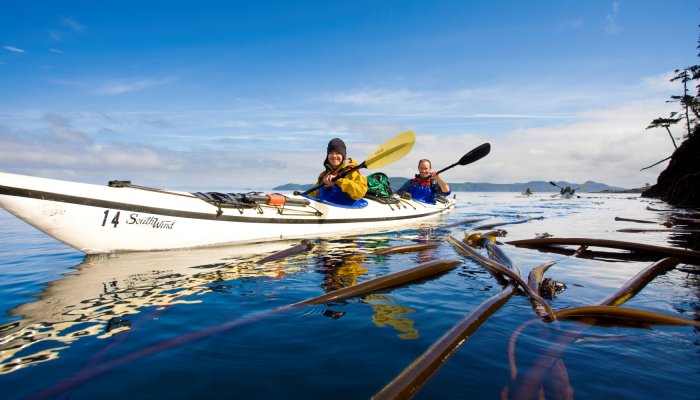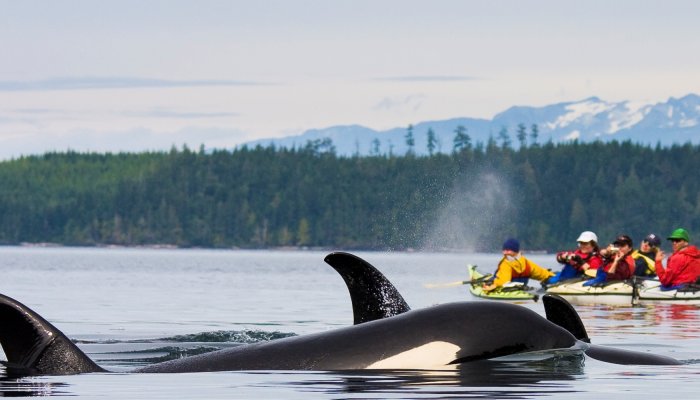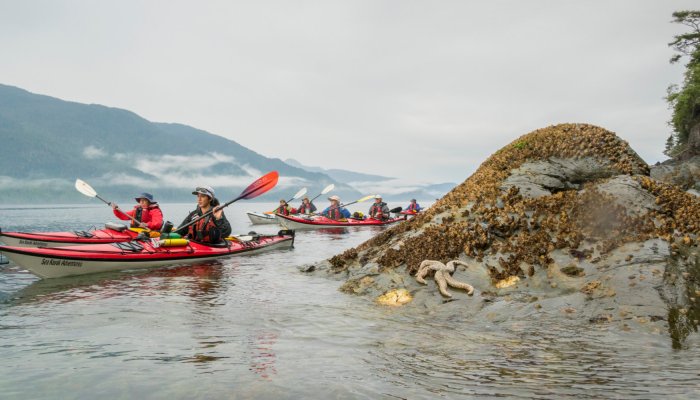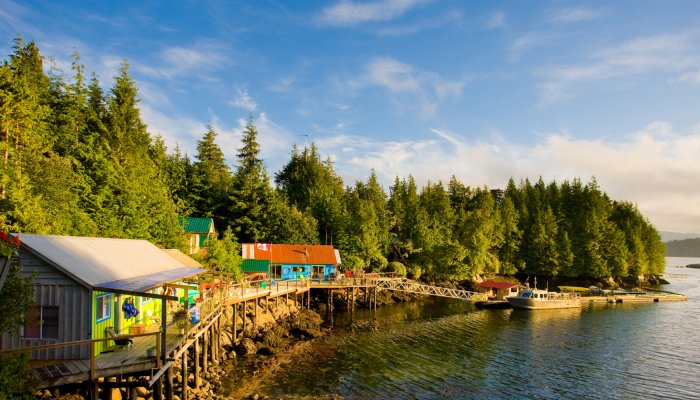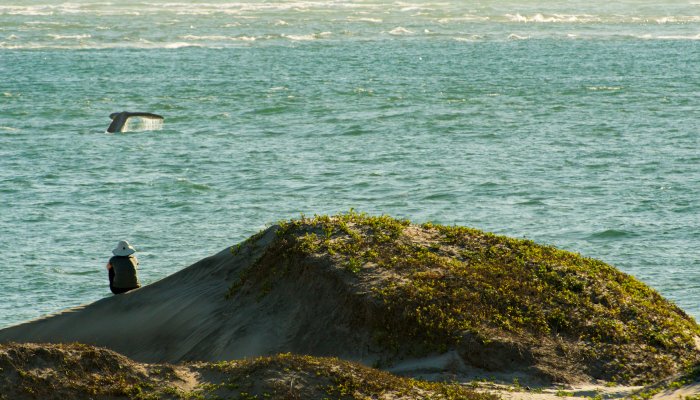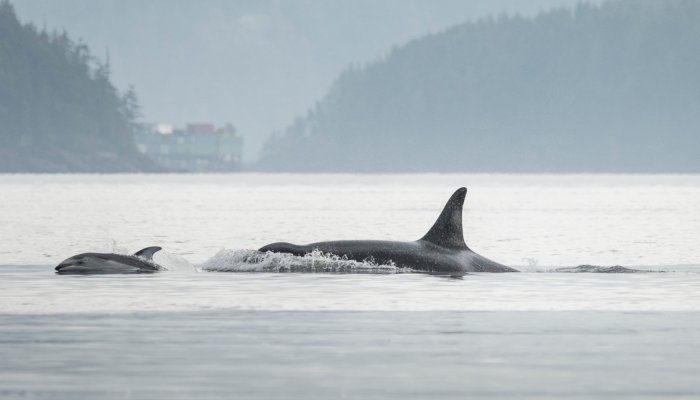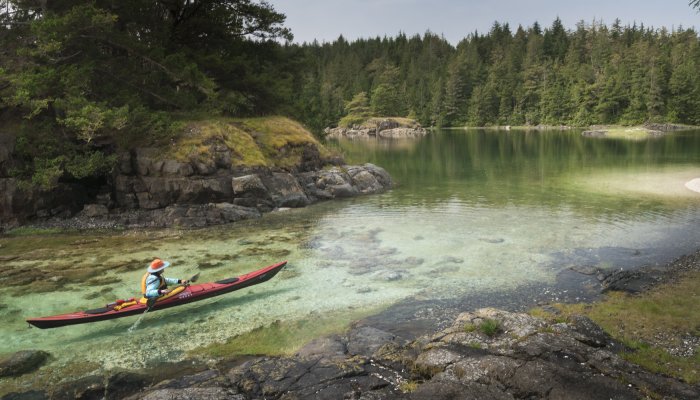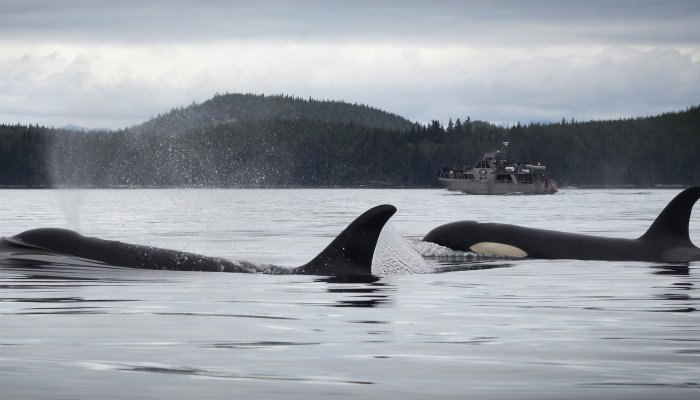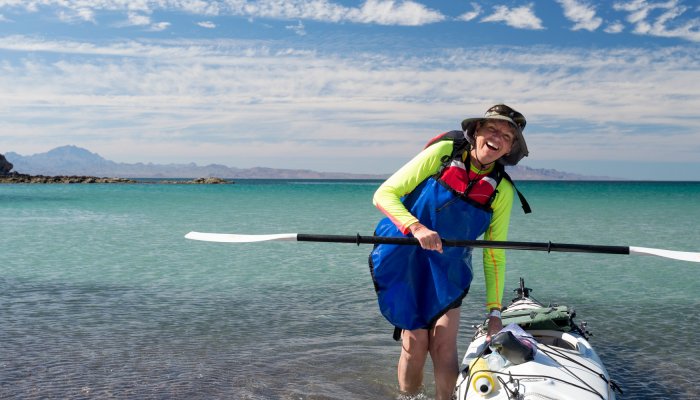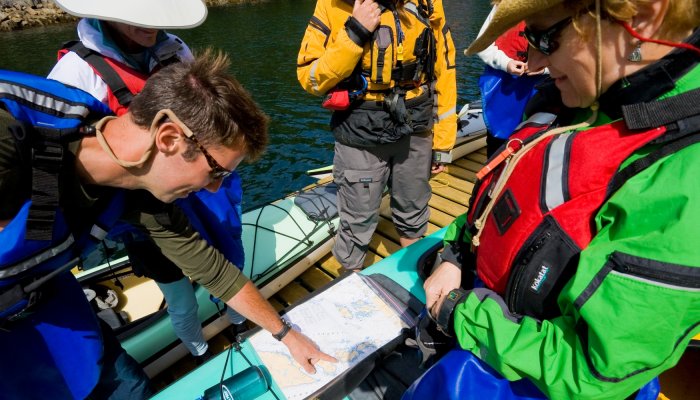Orca Kayaking Tours
Few marine wildlife encounters are more emotional than kayaking with orcas!
On our sea kayaking tours in Johnstone Strait we have a very high success rate of seeing orcas in a non-intrusive manner. Most seasons, over 90% of our guests see orcas and often the sightings are quite close. We see the orcas both when we are paddling during the day, but often, also from our evening camps.
We offer a few itineraries that provide excellent orca viewing opportunities.
4-Day Orca Base Camp Tour
For those wanting a shorter and easier kayak tour, our 4-day orca base camp tour is perfect. Paddling to and from the hamlet of Telegraph Cove, our first day is an easy paddle to our camp. The camp is made available to us by a special lease from the Namgis Nation and is set in a magical grove of cedar trees. Our canvas walk-in tents are furnished with cots and comfortable sleeping pads and sleeping bags. A classy outhouse is set under the forest canopy. Our kitchen is on the beach with sweeping views of our private bay and distant shores. We have the entire bay to ourselves at a location called “Little Kaikash” creek. Our Little Kaikash orca camp is in an ideal location as it allows us to paddle during the day to Robson Bight, a special marine preserve for orcas where human activity is strictly limited.
Not only is our orca camp close to Robson Bight, but it is located at what is known as a “rubbing beach.” Just a few feet offshore is a place where there is gravel about 15’ (5 meters) below the surface. Orcas come from miles around to rub their bellies on this gravel, perhaps to remove parasites, barnacles and the like. It’s a spectacular site to be in our camp and watch the orcas swimming underwater!
6-Day Blackfish Waters Kayak Tour
Our other sea kayaking with orcas tour is called our Blackfish Waters Kayaking tour. This is a six-day trip that has longer paddling distances and uses our three different basecamps in Johnstone Strait. On this trip we also spend a night at our Little Kaikash orca camp. In addition we spend two nights on Hanson Island and two nights on Swanson Island. Not only do we see orcas, but also a lot of humpback whales. Humpbacks are very active and often will breach, slap fins and blow their spouts impressively! Imagine yourself paddling along with these huge and magnificent creatures swimming not too far away.
Northern Resident Orcas
The waters of Johnstone Strait are home to a wide variety of marine life. Seals, sea lions, seabirds, bald eagles and much more make this their home. But the stars of the show are the orcas, sometimes called killer whales. It is here in Johnstone strait, where you can kayak with the largest concentration of resident orcas in the world!
With over 200 individual members, the social composition and range of this “northern” resident community is well studied and understood. The media tends to cover the “southern” community near the San Juan Islands of Washington State and the southern end of Vancouver Island, more than they do the “northern” community. This is because the southern group is much smaller and more endangered, and recently found to be starving due to a lack of sea-run salmon. Much of this likely has to do with the fact that this area is much more populated and industrial than the area where our trips take place, much further north.
Orcas were once feared and referred to as killer whales. In fact they are not whales at all, but highly intelligent members of the dolphin family. In the area of our Vancouver Island kayak tours, there are three types of orcas: the resident, Biggs (transient) and offshore populations.
It is the resident orcas that we see most commonly, and these are strictly fish and cephalopod eaters. The transient” community eat marine mammals exclusively (although there are some exceptions with groups that eat both fish and marine mammals.) And further out in the sea is the offshore population. There is little interaction between the resident and transient orcas and they have different behaviors, lifestyles and as noted, food preferences. You can tell the difference between the two groups by the shape of the dorsal fin and the saddle patch, which is a light colored area of skin just behind the dorsal fin. The fins of the resident orcas are round at the tip while those of the transients look more like a shark’s fin with an impressive point.
To kayak peacefully in these orca waters is such a life-enriching experience. It’s a chance to learn firsthand about these socially fascinating animals. Orcas live in closely-bonded family groups that include closely-related mothers along with their sisters, daughters, cousins and their children. A pod is usually defined as a group of orcas seen travelling together and may number from 5 to 50 individuals in the resident orcas of the Pacific Northwest and Salish Sea.
Families that are connected through acoustic traditions and associate with each other form the larger community or clan. There are three clans in the northern resident community, known as clan A, G and R. It is interesting to note that pods from separate clans do socialize with each other even though their calls are different.
Female orcas spend their entire life with their mothers. Because orcas live long lives, with females in particular living 50-80 years, the young daughters and granddaughters benefit from a multigenerational learning opportunity. This allows these societies to achieve stability, specific cultural and acoustic traditions, and long term survival success. Orca society is peaceful and cooperative, with almost no aggression between or within families.
These social, fascinating animals have been in these waters since the end of the last Ice Age some 10-12,000 years ago. This was a time when the coastal ocean became home to salmon and many other marine species. Salmon spawn in the rivers that feed the ocean, and the orcas adapted accordingly the patterns of this rich food source.
As noted, each orca pod includes the matriarch, her sisters and their offspring, collectively referred to as a matriline. Males do sometimes leave the pod to mate, but typically return to their siblings and their mother. In the waters where we kayak with orcas, there are currently 34 matrilines totaling a few more than 200 members in the northern resident community. These orcas inhabit a vast ocean area that goes from northern Vancouver Island north to southeast Alaska.
One of the gifts of science is that it is possible to identify individual orcas by their markings. Sometimes their dorsal fins get cuts or scars. As well, saddle patches are unique in shape and coloration and researchers with patience and a trained eye can identify the individuals by these differences.
Orcas have a slow growth rate, giving birth to only one calf every five or six years once they have reached sexual maturity around age 15. On our trips we carry a hydrophone, set up at our camp. This is an amazing way to listed to the distinct vocal sounds and dialects specific to each pod. Our guides are well versed in the natural history of orcas and humpbacks and on our trips you have a fantastic opportunity to learn. You will learn about the orcas lives, as well as the challenges they face today. These include lack of food due to the depletion of wild salmon. There are other threats including pollution and disease from fish farms. Acoustic disturbance is another problem as orcas depend on their hearing for survival. Not only is hearing important for communication within the pods and clans, but also to detect prey.
Be Whale Wise Guidelines
We follow the whale watching guidelines that have been established locally in order to protect and preserve the orcas. You can learn more at Cetus Research & Conservation Society.
There is still much that science is learning about orcas. One of the most inspiring things we know is that the entire orca community is a support system for each individual and they are there for each other. Aggressive behavior or overt violence has not been observed, even among males. This is a society that exhibits incredible communication, trust, acceptance, cooperation and coordination.
The population of northern resident orcas are considered “threatened” by SARA (Species at Risk Act). Further south, in the more developed island area, the southern resident whales are struggling and are listed as endangered under the SARA. Our hope is that by kayaking with orcas and connecting with these marvelous beings, you will become an advocate for their future survival. As a company we support various marine conservation organizations and you will learn more about these efforts on your kayaking trip with us.
If you’d like to prepare for your kayak tour and learn more, please visit: orcalab.org

